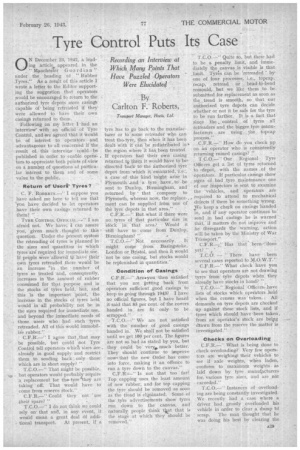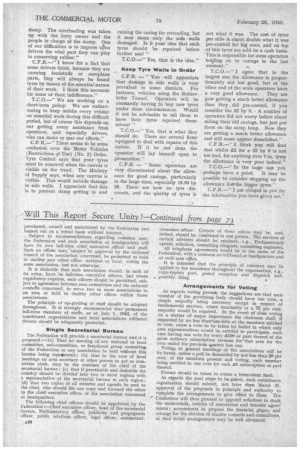Tyre Control Puts Its Case
Page 31

Page 32

If you've noticed an error in this article please click here to report it so we can fix it.
Recording an Interview at Which Many Points That Have Puzzled Operators Were Elucidated
By Carlton F. Roberts,
Traraport Manager, Rods, Ltd.•
N December 23, 1942, a le ()ad ing article appeared in the " ManchesTer Guardian" under' the heading of "Rubber Tyres." As a result of this article I wrote a letter to the Editor supporting the suggestion that operators would be encouraged to return to the autherrized tyre depots more casings capable of • being retreaded if they were allowed to have their own casings returned to them.
Following on my letter I •had, an interVievr with an official of Tyre 'Control, and Ave agreed that it Would be of interest to operators 'and advantageous to all concerned if -the result of. this interview 'could he published in order to enable opera. tors to appreciate both points of view on a number of questions of partictiJar interest to them and of some value to the public; .
• Return of Used' Tires?
C. F. ROBERTS.--.“ I suppose you have asked me here to tell me that you have decided to let operators have their ovvn casings returned to them? " , • TYRE CONTROL OF1'ICIA1..-" I am afraid not. We have 1 can assure you, given much . thought to 'this question. Under the present. system the retreading of tyres is planned in the sizes and quantities in which tyres are required for immediate u`se. If people were allowed to have their own tyres retreaded there would be an increase 'in the • number of tyres so treated ,and, consequently, increases in The Amount of rubber consumed for that purpose and in the stocks of tyres held, but, and this is the important point, the increase in the stocks of tyres held. would in all probability not be in the sires required for immediate use, and beyond the *Mediate needs of those users who. had such 'tyres retreaded. All of this Would immobil • iie rubber:: C.F.12.—" I agree that ,that may be possible, but could not Tyre Control tell operators avhicta sizes are already in good supply and restriCt them to sending back, only those which are in short supply? "
T.C.0.—" That might be possible, but operators would probably require 'a. replacement for thep tyre4they are taking ' off. That would have to come from reserve Stock."
C.F.R.—" Could they not • use Iheir spare?
T.C.0.-7" I do not think we could rely on* that an& in any event, it would mean a great deal Of addi tional transport. At present, if a tyre has to go back to the mariufacturer or to' some retreader who can treat the...tyre, then when it has been dealt with it can be redistributed in the region where it been treated. If operators had their Own casing returned to them it would have to bet 'directed -back tir the authorized tYre -depot from:which it: enianated, a case of this kind Might arise in Plymouth ',and a tyre have.tci be sent to Dunlop, Birmingham, and returned. by' that 'company to Plymouth, whereas now, the replace:. r ment can be supplied from one of the tyre depots in that area." • • C.F.R.—" But what if there were no tyres of that particular size in 'stock in 'that area? Would it still have to come from Dunlop; Birmingham? "
T.C.0.-•—" Not necessarily. It. might come 'from Basingstoke, London or Bristol, and then it would not be one casing, but stocks would be replenished in quantities."
• Condition of Casings • • Are•you then satisfied that you are getting back from operators sufficient .good casings to keep US going through 1943? I have no official figures, but I have heard it said that 85 per cent. of the covers handed in., are fit only -to be scrapped." ' • tc.o.—" We are not satisfied with the *number of good casings handed in. We shall not be satisfied until we get 100 per cent,. The figures are not so bad as stated by you, but they could be very. much better. They should .continue to improve now, that the new Order has come into force, making it an offence to run a tyre down to the canvas."
CX.R1---" Is not that too far? Top, capping uses the least amount of new rubber, and for top capping the tyre should be removed as soon as the fread is elipiinated. Some of the ,ty're adVertiseritents show tyres run down to the canvas, and naturally people think tkat that is the stage at which they should. be removed." . T.C.O.— ' Quite so, but there had to be a, penalty limit, andimmediately the canvas, is visible ris that TyrZs can be 'retreaded ' one of four processes, i.e., topcap, recap, retread or . bead-to-bead remould, but we like them to be submitted for replacement as soon as the ,tread is Smooth, so that our authorized . tyre depots can decide whether or not it be safe for the tyre to be run farther. It .is a fact that since The control of tyres all retreaders' and the bigger tyre manufacturers . are using the topcap process." ,.C.F.R.7-•" How do you check pp on an operator who is consistently returning ruined casings?' " • T C.0.—" Our Regional • Tyre Officers get a list of tyres returned to -depot, with the names .of the operators. If particular casings show signs of bad tyre Maintenance one of our inspectors is sent to examine the vehicles, and operators are required to attend to mechanical defects if there be something wrong. .)Ve keep a cheek on casings handed in, and if any operator continues send in bad casings he is warned that, i matters do. not iniprove and he tlisregardS the 'warning, action will be taken by the Ministry of War Tratisport.' .
C.F.R.-7:' Has that been-done yet? " ' T.C.O. — "There have been several cases reported to M.O.W.T." C.F.R.—" What check have you to see that operators are notdrawing tyres from tyre depots when they already have stocks in hand? " _ • T.C.0.—" Regional 'Officers. have lists of stocks which operators held when the census was • taken. All demands on tyre depots are checked up against these stock lists, and if tyres which should, have •been taken from an operator's stock are beipg 'drawn from the reserve the matter is investigated," Checks on Overloading C.F.R.—" What is being done to check overloading'? Very few operators are weighinga their vehicles to see • if axle weights, when laden, conform to maximum weights. as laid down by tyre . manufacturers for, various tyre sizes, and are not exceeded."
Instances of overloading are being constantly investigated. , We recently had a case where a driver had, grossly overloaded his vehicle in order to clear a dump bf scrap. The man thought that he was doing his best by clearing the dump. The overloading was taken up with the lorry owner and the people in charge of the dump. One of our difficulties is to impress upon drivers the vital part they can play in conserving rubber."
C.F.R.—" I know for a fact that some drivers think, because they are carrying foodstuffs or aeroplane parts, they will always be found tyres by reason of the, essential nature of their work. I think this accounts fcir some of their, indifference."
T.C.0.—" We are working on a short-term policy. We are endeavouring to keep mobile every vehiole on essential work during this difficult period, but of course this depends on our getting every assistance from operators, and especially drivers, who can make or mar our efforts."
C.F.R,—" There seems to be some confusion over the Motor Vehicles (Restrictions of Use) (No. 2) Order. Tyre Control says that your tyres must be removed when the canvas is visible on the tread. The Ministry of Supply says, when any canvas is visible. This would include damage to side walls. I appreciate that this. is to prevent damp getting in and ruining the casing for retreading, but it may mean only the side walls damaged. Is it your idea that such tyres should be repaired before further use? "
T.C.0.—" Yes, that is the idea.", Keep Tyre Walls in Order C.F.R. — "You will appreciate that darnage to side walls is very prevalent in some districts. For instance, vehicles using the Rotherhithe Tunnel. Operators will be constantly having to buy new tyres under these circumstances. Would it not be advisable to tell them to have their tyres repaired themselves? "
T.C.0.—" Yes, that is what they should do. There are several firms equipped to deal with repairs of this nature. If it be not done the operator will lay himself open to prosecution."
C.F.R. — "Some operators are very discontented about the allowance for good casings, particularly in the large sizes, especially 13.50 by 20. There are now no tyre discounts, and the quality of tyres is not what it was. The cost of tyres per mile is about double .what it was pre-control' for big sizes, And on top of this tyres are,scild on a cash basis. This is responsible for some operators hoLding on to casings to the last moment."
T.C.0.—" I agree that in the largest size the allowance is proportionately not too good, but at the Other end of the scale operators have a very good allowance. They are tiow getting a much .better allowance than they, did pre-control, if you consider the 32 by 6. • A number of operators did not worry before about selling their old casings, -but just put them on the scrap heap. Now they are getting a much better allowance and still some appear dissatisfied."
C.F.R.—" I think you will find that whilst £2 for a 32 by 6 is not , too bad, for anything over 7-in. tyres the allowance is very poor indeed.''' T.C.O.—'' In the large size you perhaps have a point. It may be possible to. consider stepping up the allowance fot•the bigger tyres."
C.F.R.—" I am obliged to you for the information 'You have given me."




















































